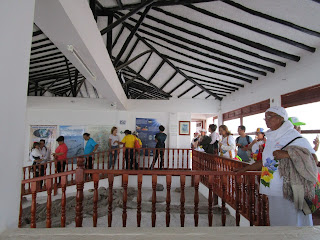 |
| Kronosaurus Boyacensis |
Oh, I guess I should add that was $150,000 COP, Colombian pesos, not $150,000 USD. $150,000 COP equals about $50. Not bad at all for a one-turista, five-hour tour by taxi.
The trip started with a visit to El Centro de Investigaciones Paleontológicas, the Paleontological Research Center, to get some background on the giant fossil for which VDL is known.
Not quite knowing where I was, I thought the above was the "El Fosil," The Fossil, the giant Kronosaurus that put Villa De Leyva on the map paleontologically speaking. I figured out quickly it wasn't. The above is impressive, but it's smaller and has some replicated parts.
Here's my first Amonita fossil of the day.
Amonitas, or Amonites, are (or were) mollusks.
This is a turtle fossil found in the area, with a silhouette of a typical man for size comparison:
I received a very good English language tour from my guide in the research center.
Fish bone fossil:
More ancient sea critters:
My guide explained to me -- in very good English -- what these were, but it's been a long day.
The blue fish hanging above is not a fossil. I just thought it was cool. Added some atmosphere to the joint.
This is a map that shows why this area is so rich in fossil finds. One hundred million years ago this was ocean. The Andes split into three ranges, called "Cordilleras," in Colombia. Only the western most of three cordilleras had risen at this point. It's an impressive bit of plate tectonics to get two new and huge mountain ranges to rise up in that short of time, paleontologically speaking once again.
This was the coast. It's now 7000ft in elevation, between the central and the western cordillera, and it was beachfront real estate back then.
The famous "El Fosil" is not here in El Centro de Investigaciones Paleontológicas, even though the center exists at this locale specifically because of "El Fosil." "El Fosil" is across the street. In its own museum. With its own admission charge. Both of which were dirt cheap, maybe two or three bucks U.S. dollars.
And here he is:
Kronosaurus boyancensis.
In 1977, some workers were excavating as part of the construction of a new road. They found this:
The fossil was so huge and so perfect that they decided not to move it. Instead, they built a museum around the fossil. This museum.
Other fossils have been trucked in.
Amonitas!
Here's a whole wall of amonites:
Want to see some more? Imprints of leaves long fallen.
I shot this next pic because of the cool painting on the wall depicting these creatures on the hunt.
This place was crowded with tourists. Bus tourists. Mostly older women. Just like the U.S.A.! Only these tourists from within Colombia, I believe. I don't think they bused down from Kenosha or Kittanning or Codger's Corners.
(At one point in my life I would've made a "joke" about fossils viewing fossils, but, now, I am of the fossil age myself and that sort of thing just isn't funny anymore.)
OK. Just the one. Fossil selfie at the fossil:
I don't want you to think that I'm one of those people who's constantly shooting selfies, even though I'm shooting a selfie with Kronosaurus Boyancensis himself. Besides, I'm not using one of those infernal selfie sticks and, as you can see, I'm not spending much time if any on staging. Just reach out and shoot.
Outside really did have the feel of good ol' all American tourist trap:
Souvenirs a-plenty. Ice cream for sale.
No time for a cone for me, however. Time to get into the taxi for the next destination in the $150,000 tour of Villa De Leyva.























Not a bad read for a click-bait title :)
ReplyDelete